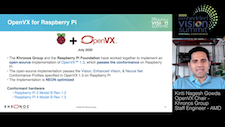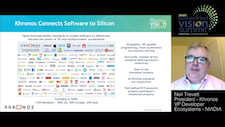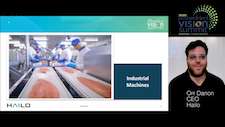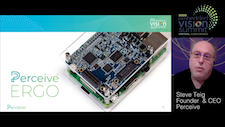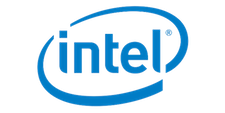| LETTER FROM THE EDITOR |
Dear Colleague,
Tomorrow, February 25, 2021 at 9 am PT, Edge Impulse will deliver the free webinar “How to Rapidly Build Robust Data-driven Embedded Machine Learning Applications,” in partnership with the Edge AI and Vision Alliance. In this in-depth tutorial, you’ll learn how to build commercial embedded machine learning (ML) applications, in robust implementations ranging from simple sensor configurations to powerful computer vision deployments. Topics covered in the webinar will include:
The webinar will include live demonstrations of the concepts discussed, and is co-presented by Zach Shelby, CEO and co-founder, and Daniel Situnayake, founding ML engineer, both of Edge Impulse. For more information and to register, please see the event page. And on Thursday, March 11, 2021 at 9 am PT, GrAI Matter Labs will deliver the free webinar “Brain-inspired Processing Architecture Delivers High Performance, Energy-efficient, Cost-effective AI” in partnership with the Alliance. If a picture is worth a thousand words and a video is worth a million, how do you enable ultra-fast, efficient, and cost-effective edge AI for a world immersed in video? GrAI Matter Labs has developed a processor that delivers the fastest AI per Watt using a technology called NeuronFlow. NeuronFlow is the product of brain-inspired computing, with scalable digital technology that is easily programmable to enable real-time response systems with minimal power consumption, size and cost. In this session, GrAI Matter Labs VP Mahesh Makhijani will present a number of use cases enabled by the company’s partners using its NeuronFlow technology. For more information and to register, please see the event page.
The Alliance is now accepting applications for the 2021 Edge AI and Vision Product of the Year Awards competition, with the final round taking place live online during the Embedded Vision Summit. The Edge AI and Vision Product of the Year Awards (an expansion of previous years’ Vision Product of the Year Awards) celebrate the innovation of the industry’s leading companies that are developing and enabling the next generation of edge AI and computer vision products. Winning a Product of the Year award recognizes your leadership in edge AI and computer vision as evaluated by independent industry experts. The application deadline is Friday, March 19; for more information and to enter. please see the program page. Brian Dipert |
| EVOLVING INDUSTRY STANDARDS |
|
Democratizing Computer Vision and Machine Learning with Open, Royalty-Free Standards: OpenVX Khronos Standard APIs for Accelerating Vision and Inferencing |
| EDGE INFERENCE PROCESSORS |
|
Lessons Learned from the Deployment of Deep Learning Applications In Edge Devices Data Center-Class Inference in Edge Devices at Ultra-Low Power |
| UPCOMING INDUSTRY EVENTS |
|
How to Rapidly Build Robust Data-driven Embedded Machine Learning Applications – Edge Impulse Webinar: February 25, 2021, 9:00 am PT Brain-inspired Processing Architecture Delivers High Performance, Energy-efficient, Cost-effective AI – GrAI Matter Labs Webinar: March 11, 2021, 9:00 am PT Selecting and Combining Deep Learning Model Optimization Techniques for Enhanced On-device AI – Nota Webinar: March 23, 2021, 9:00 am PT Enabling Small Form Factor, Anti-tamper, High-reliability, Fanless Artificial Intelligence and Machine Learning – Microchip Technologies Webinar: March 25, 2021, 9:00 am PT Optimizing a Camera ISP to Automatically Improve Computer Vision Accuracy – Algolux Webinar: March 30, 2021, 9:00 am PT |
| FEATURED NEWS |
|
Renesas Develops Automotive SoC Functional Safety Technologies for CNN Accelerator Cores and ASIL D Control Combining Performance and Power Efficiency Vision Components’ VC picoSmart, Only Slightly Larger Than a Typical Image Sensor Module, Contains All Components Necessary for Image Processing Europe-based Unikie Joins the Edge AI and Vision Alliance to Extend Its Technology Reach to the U.S. and Other Global Markets Videantis Passes Milestone, Enabling 10 Million Production Vehicles The Arm Ecosystem Ships 6.7 Billion Arm-based Chips in a Single Quarter |
| VISION PRODUCT OF THE YEAR WINNER SHOWCASE |
|
Intel DevCloud for the Edge (Best Developer Tool) |



